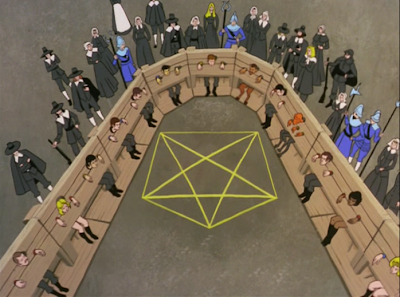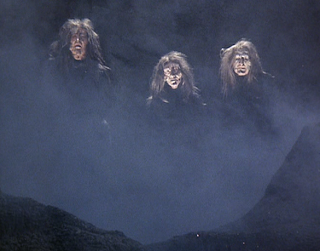In the 80s hard rock world, people telling you how to rock or even worse maneuvering to obstruct your access to rock were the worst people in the world. This message was delivered over and over again. In the world of the future imagined in Quiet Riot's "The Wild and the Young" video, the first single from the band's third * album QR III, this is taken to the logical extreme: a totalitarian regime centered entirely around the idea of depriving the population of rock and brutally oppressing any who defy this decree.
 |
| * Technically, they had a few albums before what is commonly known as their first, but there's no need to get into all that. |
 |
Here we see people's axes being confiscated and thrown in the wood guitar chipper. |
 |
| Oh no! That metal mask is the Quiet Riot mascot! Has he joined the state-sponsored War on Rock? |
 |
| Never fear: |
 |
| Frankie (Banali, the drummer) is here. Our man on the inside. |
Despite being introduced seconds before as a prisoner being unloaded from one of the armored buses, Frankie is somehow able to pose as one of the guards (above) and lead his band-mates (Kevin Dubrow, Carlos Cavazo, and Chuck Wright) down a sewer and a conveyer belt to an underground storehouse of captured instruments. He gets behind the drums, everyone settles into their rock band roles, and they start rocking out.
  |
 The sun never sets! For souls on the run! The wild and the young... The sun never sets! For souls on the run! The wild and the young...  |
 |
| They are watched on the video monitors by very angry women in military uniforms. |
Their anthem inspires their fellow rock prisoners to revolt, and fascist thugs soon surround our heroes and train their guns on them.
 |
| But wait! |
 |
| It was just a dream. Or WAS IT? |
 |
| Wink Martindale reports that Congress has just passed a law requiring all albums to have their lyrics printed on the back cover so parents can know what it is their kids are buying. IS THIS HOW IT STARTS? |
This was a common anxiety at this time in hard rock history. Around the same time, Grim Reaper wrote the classic "
Rock You To Hell" which asked America "Is this the beginning of the future? No books, no sound, no rock and roll? Don't let other people run your liii-iii-AI-YI-YI-IIIIFE!!" See also:
 |
| Or Whitesnake's "Still of the Night," which saw David Coverdale detained at the end by The Rock Police's sister agency. Or Corey Hart's: |
 |
| One of the odder entries in this sub-genre of 80s Orwellian-themed videos. |
Back to "The Wild and the Young." After Kevin wakes up and Wink's pronouncement from the tv, the camera pans to the bus driver:
 |
| Oh no! Carrie White Burns in Hell! |
The tour bus is driven into a warehouse where, presumably, the anti-rock concentration camp of Kevin Dubrow's nightmare has become a reality.
I'm going to assume you already have this one bookmarked or on a playlist or are probably listening to it
right now. What? You don't? You aren't? Here's a link to the
video.
 |
| Rockers go in, but they don't come out. |
 |
| At least with their pants. |
These last two screencaps really made me chuckle. Presumably they couldn't find many extras who were willing to have their heads shaved. Don't touch the hair, bro. There is a scene where a longhair is strapped to a chair while two shirtless mustached dudes gleefully shorn his locks, but the scene is so poorly lit that screencapping it doesn't really convey it too well:
 |
| Likewise, this shot of a gas-masked thug about to beat a rocker in shackles amidst a swirl of escaping steam. |
I have no idea who directed this video. I'm charmed by this, actually; it's nice to find out there are some mysteries a Google search cannot instantly solve. It also allows for me to assume this was directed by David Fincher. Or maybe even David Lynch, a prequel (or a sequel) to the bizarre 60 second entry he contributed to the
Lumiere film.
It was meant to revive Quiet Riot's fortunes, which had ebbed in the three years since they achieved massive success with Metal Health. But the video (and their makeover from skinny street urchins to poofed-out Edwardian-garbed rock insurrectionists) failed to excite MTV viewers and despite repeated phone calls from your humble narrator to the folks at DIAL-MTV, came and went. QR III was a commercial disappointment, and Kevin Dubrow was fired shortly thereafter.
 |
| Attempts to keep the band afloat with a different singer were similarly unsuccessful. |
Chuck Klostermann wrote the book, literally,
on this sort of thing, but he gives scant space to Quiet Riot.
Understandably, I guess, but I never got the memo. I went on listening to Quiet Riot throughout the 80s, blissfully unaware of their woes, insulated in my bubble of Circus, Blast, and Hit Parader magazines.
 |
| Their stay at the top of the McPyramid of Absolute Rock lasted only from when I first heard "Bang Your Head" to when I first heard Pyromania. |
 |
| I remember being surprised that no one else on the bus had memorized all the words to Condition Critical, their follow-up to Metal Health, over Christmas break. |
It's easy to look back on both the video and the song as a rather calculated and formulaic appeal to adolescent allowance money, but
"The Wild and the Young" remained an anthem of my teenage years for far longer than it should have. (It and Bon Jovi's "To The Fire," which was right after it on an old mix tape I had and thus comes to mind whenever I think of it.) And the video, obviously, made quite an incursion into my developing brain.

The allusions to the
PMRC throughout the video are a little dated, making it seem like the two ladies in military uniforms are simply generic fuddy-duddies. But they were pointed references to Tipper Gore and the other "Washington Wives," whose campaign to put parental warnings on albums which featured gratuitous allusions to sex (i.e. 98% of "cock rock") and/or violence or drugs (the other 1.5%, with .5% reserved for Iron Maiden's ownership of the "Historical Fiction and Songs about Movies" category) made them Public Enemy Number One for the heavy metal faithful. Motley Crue brazenly changed the lyrics in their cover of "Anarchy in the UK" to include a reference to them ("Is this the PMRC?!" they chant incredulously at song's end) and artists as diverse as Cyndi Lauper, Jello Biafra, Rage Against the Machine, and Frank Zappa all released anti-PRMC material.
The "Parental Advisory" sticker ended up helping any artist or band to whose album it was affixed, and as the 90s turned into the 21st century, this forgotten and shameful chapter in American history was put to rest with the Advent of Britney. While we seem to have been spared the Sex and Rock and Roll Police on every corner, we ironically have less freedom in 2013 than we did in 1986, despite rock and roll's increasingly reductive orgy of sex and death going mainstream. What was shocking for W.A.S.P. to say back then is simply expected of our young pop princesses now.
 |
| Still from Nicky Minaj's "Stupid Hoe." Can you imagine Blackie Lawless (i.e. the dude from W.A.S.P. who wrote more than a few of the songs the PMRC was so up in arms about) as a judge on American Idol? The idea is preposterous for a few different reasons, but it would have been unthinkable in the 80s. |
Quiet Riot still tours and more power to them. Any fun had at their or this video's expense is certainly at my own, as well; in the 80s, I was as eager to answer the call for the jihad against those who would tell us how to rock as any in my marketing demographic.
Times are changing
nothing stays the same
for this Jukebox Generation...
 |
| Kevin Dubrow, 1955-2007, RIP. |









































































